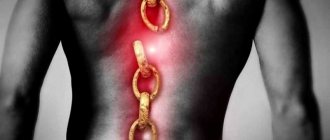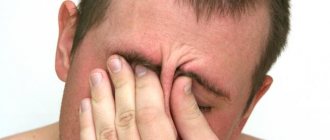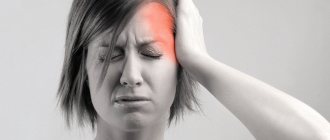Signs that pain in the cervical region is radiating to the head
This symptom is usually characterized by initial pain in the neck, after which it “shifts” to the head. Neck pain is most often caused by various pathological processes occurring in this area:
- inflammatory;
- degenerative-dystrophic;
- traumatic origin.
Headaches that occur due to problems in the cervical spine are called cervical. It is different from “classic” migraine. Cervical pain is usually defined as dull pain, often localized in the back of the head, but sometimes spreading to the temples and eyes. Even less commonly, it appears in the upper part of the head (forehead and crown), as well as in the ear area. This pain is often accompanied by:
- stiffness and pain in the neck (when trying to turn the head);
- tingling or numbness in the shoulder girdle and arms;
- dizziness (with nausea);
- ringing in the ear;
- inability to concentrate;
- muscle weakness;
- depression.
According to the nature of its manifestation and connection with the provoking pathological mechanism, cervical pain can be:
- arteriospastic (aching pain is observed in all parts of the head);
- arteriodilatatory (pain of a pulsating nature is localized in the temples and back of the head);
- venous (pressing pain in the morning);
- muscular-tonic (aching in nature, encircling the parietal region with a “hoop”);
- liquor-hypertensive (bursting in nature with pressure on the eyes);
- neuralgic (with attacks of “shooting” pain).
Reasons for appearance
Unpleasant sensations in the temple area are not always associated with diseases. Causes of headache:
- intoxication - toxic fumes from building materials or household chemicals provoke a feeling of constriction in the temples;
- high emotional stress - tension headaches that occur against the background of severe stress or fatigue;
- weather sensitivity - a sudden change in weather provokes unpleasant sensations in a group of people.
If none of the reasons apply, you should take care of your health and consult a doctor. During the examination, a disease may be identified that causes headaches in the temples.
Read also: Headache in the forehead area
Who more often experiences pain in the cervical spine radiating to the head?
This symptom does not depend on race, gender, or age. Moreover, it is usually more often observed in people aged 20 to 60 years and older (since it is directly related to the development of cervical osteochondrosis, which affects almost 90% of people after 65 years). According to statistics, cervical pain is most often recorded in those who:
- has a sedentary job in an office at a computer;
- works professionally as a driver;
- associated with regular strength loads (professionally or in sports);
- has chronic problems with normal cerebral circulation;
- suffered injuries to the cervical spine;
- has a genetic predisposition.
Prevention of shooting pain in the temple
For prevention, it is necessary to undergo an annual medical examination.
To avoid suffering from pain in the temples, you need to engage in prevention, following the recommendations of specialists:
- observe the work and rest schedule, sleep at least 7-8 hours a day;
- lead a healthy lifestyle, do not indulge in alcoholic beverages, smoking, coffee;
- Eat properly and nutritiously and be sure to have breakfast. The diet of an adult should contain fresh vegetables and fruits, herbs, red and white meat, fermented milk drinks;
- half an hour before breakfast, drink a glass of filtered water;
- regularly spend time in the fresh air;
- do not forget about physical activity;
- undergo a medical examination once a year.
Pain in the temples is caused by various reasons. It can be episodic or constant. In the first case, it is enough to rest fully, drink a cup of tea and take a painkiller. If discomfort is constantly felt, you should not hesitate to go to the doctor.
What diseases cause pain in the cervical region to radiate to the head?
The most common causes of this symptom are the following diseases or pathological conditions:
- cervical osteochondrosis – observed in almost 90% of elderly people, which is associated with age-related deformation of the bones and cartilage that make up the cervical spine, with severe pain localized at the base of the skull, in the temples, often accompanied by decreased vision (against the background of eye “fatigue”), can also develop due to a passive lifestyle, excess weight or genetic predisposition;
- spinal injuries – including microtraumas received from impacts, falls during sudden braking or acceleration while the vehicle is moving;
- circulatory disorders - due to hypertension, or insufficient blood flow to the brain due to atherosclerosis of the vertebral artery;
- cervico-occipital neuralgia - pain spreads along the head, covering the temples, eyes and forehead (in the direction of the affected nerve);
- stress and physical or mental exhaustion - neck pain radiating to the head, in this case, serves as a prerequisite for the development of osteochondrosis.
Treatment with traditional and folk remedies
If it shoots in the left temple, or the pain constantly radiates to the right side of the head, to relieve unpleasant symptoms, drugs from the group of analgesics based on paracetamol or acetylsalicylic acid are used. When the cause is determined, the specialist may prescribe other medications:
- Triptans: Naratriptan, Sumatriptan, Naramig, Zomig. Used for migraines.
- Combined action opioid analgesics: Tramadol, Butorphanol, Phenibut, Ultram. They have a long-lasting and powerful effect.
Depending on the type of disease, patients are prescribed sorbents, antibacterial, anti-inflammatory, sedatives, antipyretics, medications that improve blood circulation in the brain and eliminate vascular swelling.
Complex treatment includes taking not only systemic, but also local medications, for example, warming ointments and creams, when spasms in the head are caused by hypothermia or prolonged exposure to the cold. The use of physiotherapy is not excluded:
- medicinal baths;
- mud wrapping;
- magnetic therapy;
- electrophoresis;
- acupuncture.
Home remedies speed up the healing process, help relieve pain, strengthen blood vessels, and improve immunity. Traditional healers advise using the following recipes:
- Cut fresh cabbage leaves with a knife and mash until the juice releases. Place it on your head, secure it with cling film, and tie a scarf around your head. After 1-2 hours, change the sheet. Remove the compress when the pain goes away.
- Drink a glass of freshly squeezed orange juice with a few drops of lemon juice.
- Pour a large spoonful of fireweed (fireweed tea) into a glass of water and simmer over low heat for 15 minutes. After infusion, strain and take a tablespoon three times a day.
Rubbing clove essential oil into your temples can help you quickly get rid of headaches. Lavender, mint, bergamot, and fir oils have an analgesic and relaxing effect.
Which doctor should I see?
If pain in the cervical spine radiates to the head , it is better to immediately contact a neurologist (or orthopedist-traumatologist) to accurately diagnose the current condition and identify the causes of pain in the neck and head. This is especially true for pain that does not stop for several days or often recurs.
Are you worried about neck pain that radiates to your head? Don't waste your time. Qualified medical specialists are always ready to determine the exact cause of your illness and return you to the true joy of life without pain as quickly as possible!
First aid for pain in the temples
During an attack of pain, a cold compress will help.
Pain in the head is often debilitating, knocking the ground out from under the patient’s feet, disorienting him in space, depriving him of strength. Therefore, it is necessary to provide him with comfortable conditions: create silence, ventilate the room, darken the windows. To alleviate the condition:
- applying a cold compress to the problem area of the head;
- massage of temples, neck and shoulders using essential oil;
- warm chamomile infusion or sweet black strong tea with the addition of a slice of lemon;
- taking a painkiller (Citramon, Spazmalgon, Paracetamol, Ibuprofen).
Recurrent headaches in the temples are a signal to immediately seek medical help. In this case, you need to remember the nature of the pain, accompanying symptoms, and determine the presence of provoking factors. Keeping records will allow the doctor to quickly establish a diagnosis and prescribe the correct treatment.
Diagnostics
Since there are many reasons that provoke a headache in the left temple, a comprehensive examination is required to identify them. As part of diagnostic measures, the following are prescribed:
- general and biochemical blood test;
- electroencephalography of blood vessels in the brain and cervical region;
- Magnetic resonance imaging;
- lipid profile;
- consultation of specialized specialists (ophthalmologist, neurosurgeon, psychiatrist, neurologist and others).
After a diagnostic study, the doctor prescribes appropriate treatment.
Features of therapy
Depending on what disease is causing the pain in the left side of the head, a specialist will prescribe treatment. The following medications can be used as part of therapy:
- sorbents;
- anti-inflammatory drugs;
- drugs that relieve swelling of blood vessels;
- antipyretic substances;
- antibacterial medications;
- sedatives.
Warming ointments can also be prescribed if the pain appears as a result of prolonged exposure to a draft. In addition, physiotherapeutic procedures are carried out, including:
- mud wraps;
- baths;
- massages;
- magnetic therapy;
- electrophoresis;
- acupuncture.
In cases where the headache is caused by overwork, overeating or a strict diet, it is important to change your lifestyle and diet to eliminate the causes of the malaise.
Mechanism of occurrence
Painful sensations occur due to irritation of the nerve trunks. First, a pathological impulse is formed in the nerve fibers, as a rule, this occurs due to some provoking factor, mechanical damage or inflammatory process affecting nerve processes or muscle tissue.
As a result, the pathological process affects the structure of neurons, and the nerve fibers cease to perform the function of “inhibition”.
As a result, a short-term pain impulse is formed that spreads throughout the entire nerve trunk. This is how a sharp pain arises, which is often accompanied by pulsation.
It is important to realize that pain in the temporal region of the head is not an independent disease, it is a concomitant symptom indicating some kind of disorder in the body.
Related symptoms
The pain can affect either one lower limb or both. Often a person experiences the following symptoms associated with this pain:
- heaviness in the legs;
- lower back pain;
- feeling of a “lumbago” in the back, lower back or legs;
- inability to bend the leg;
- irritability, unusual mood swings, increased fatigue, insomnia. This may be directly related to discomfort from pain, or it may be a signal of problems with neurology.










